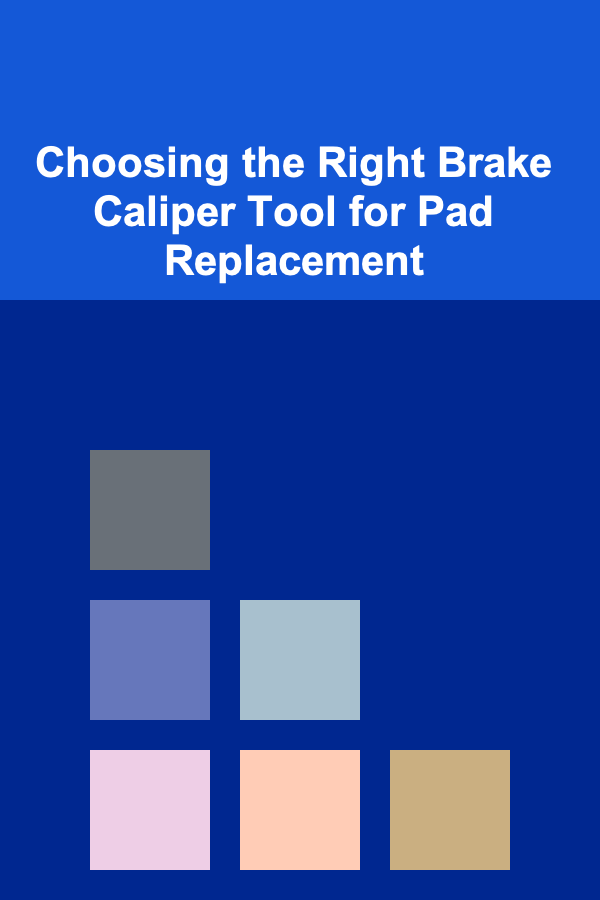
Choosing the Right Brake Caliper Tool for Pad Replacement
ebook include PDF & Audio bundle (Micro Guide)
$12.99$5.99
Limited Time Offer! Order within the next:

Replacing brake pads is a common automotive maintenance task that, while manageable for the DIY enthusiast, often requires specialized tools to perform correctly and safely. Among these tools, the brake caliper tool stands out as crucial for retracting the caliper pistons to make room for new, thicker brake pads. Selecting the right brake caliper tool isn't just about convenience; it's about ensuring the job is done efficiently, without damaging the vehicle, and with the peace of mind that comes from using the appropriate equipment. This in-depth guide will explore the various types of brake caliper tools available, the factors to consider when choosing one, and how to use them effectively.
Understanding the Need for Brake Caliper Tools
Before diving into the specifics of brake caliper tools, it's important to understand why they are necessary. Brake systems rely on friction to slow down or stop a vehicle. This friction is generated when the brake pads are pressed against the brake rotors by the caliper pistons. As the brake pads wear down, the pistons extend further out of the caliper to maintain contact with the rotor. When it's time to replace the brake pads, the pistons need to be pushed back into the caliper housing to create enough space for the new, thicker pads.
Attempting to simply force the pistons back in without the proper tool can lead to several problems:
- Damage to the Caliper: Applying excessive force can damage the piston seals or the caliper body itself, leading to leaks and compromising the braking system's integrity.
- Damage to the Master Cylinder: Forcing fluid back into the master cylinder too quickly can damage internal components and cause brake failure.
- Increased Risk of Injury: Improper techniques can lead to accidents and injuries, especially if the caliper suddenly releases or the tool slips.
- ABS System Complications: In some vehicles, particularly those with electronic parking brakes, forcing the piston back improperly can damage the ABS system and require expensive repairs.
Therefore, using a specialized brake caliper tool is essential for safe and effective brake pad replacement.
Types of Brake Caliper Tools
The market offers a variety of brake caliper tools, each designed for specific types of calipers and vehicles. Understanding the different types is crucial for making the right choice.
1. C-Clamp: The Simple Solution
The C-clamp is the most basic and arguably the most versatile brake caliper tool. It consists of a C-shaped frame with a screw mechanism that allows you to apply pressure to the caliper piston. It's a relatively inexpensive option and can be used on many single-piston calipers.
Pros:
- Affordable: C-clamps are generally inexpensive.
- Versatile: They can be used on a wide range of single-piston calipers.
- Easy to Use: The operation is straightforward, requiring only manual tightening of the screw.
Cons:
- Can Be Difficult to Use on Tight Spaces: The bulk of the C-clamp can make it challenging to use in confined areas.
- Requires Careful Application of Force: Over-tightening can damage the caliper piston.
- Not Suitable for Parking Brake Integrated Calipers: C-clamps are not appropriate for calipers with integrated parking brake mechanisms that require rotational force.
How to Use:
- Remove the old brake pads.
- Place the metal pad or old brake pad (or a suitable flat piece of metal) against the piston face to protect it.
- Position the C-clamp so that the screw end presses against the pad and the back of the clamp rests against the caliper body.
- Slowly tighten the screw to retract the piston, monitoring the process to ensure it's moving smoothly and evenly.
2. Caliper Piston Compressors: Versatility and Efficiency
Caliper piston compressors are designed specifically for retracting brake caliper pistons. They come in various designs, including screw-type compressors and ratchet-type compressors. These tools provide more controlled and even pressure than a C-clamp.
Pros:
- Controlled Pressure: They allow for more controlled and even pressure, reducing the risk of damage.
- Easy to Use: Most compressors are designed for easy operation, even in tight spaces.
- More Efficient Than C-Clamps: They often allow for faster piston retraction.
Cons:
- Can Be More Expensive Than C-Clamps: Quality compressors can be more expensive than basic C-clamps.
- May Not Fit All Caliper Types: Some compressors may not be compatible with all caliper designs.
How to Use:
- Remove the old brake pads.
- Place the compressor tool over the piston. Some may require specific adaptors.
- Tighten the screw or ratchet mechanism to retract the piston, ensuring even pressure and smooth movement.
3. Wind-Back Caliper Tools: For Integrated Parking Brakes
Wind-back caliper tools are specifically designed for calipers with integrated parking brake mechanisms. These calipers require the piston to be rotated while it's being pushed back into the caliper. Attempting to force these pistons straight back can severely damage the parking brake mechanism.
Pros:
- Essential for Integrated Parking Brakes: These tools are the only safe way to retract pistons on calipers with integrated parking brakes.
- Prevents Damage: They prevent damage to the parking brake mechanism.
- Designed for Specific Vehicle Makes: Often come with adapters for various vehicle makes and models.
Cons:
- More Expensive: These tools are generally more expensive than C-clamps or simple compressors.
- More Complex to Use: They require more careful operation and often come with specific instructions.
- Specialized: They are only necessary for specific types of calipers.
How to Use:
- Remove the old brake pads.
- Select the correct adapter for your vehicle's caliper. The adapter will fit into notches on the piston face.
- Attach the adapter to the wind-back tool.
- Position the tool on the caliper and slowly rotate the handle while simultaneously pushing inward. The piston should retract as it rotates.
- Consult your vehicle's repair manual for specific instructions and torque settings.
4. Electronic Parking Brake (EPB) Service Tools: The Digital Solution
For vehicles equipped with electronic parking brakes (EPB), a diagnostic tool is often required to put the parking brake system into service mode, which retracts the EPB motor before the brake pads can be replaced. These tools connect to the vehicle's OBD-II port and communicate with the EPB control module.
Pros:
- Required for EPB Systems: These tools are often the only way to safely retract the EPB motor for brake pad replacement.
- Prevents Damage to EPB System: Using these tools prevents damage to the EPB motor and control module.
- May Offer Other Diagnostic Functions: Many EPB service tools also offer other diagnostic functions.
Cons:
- Most Expensive Option: These tools are typically the most expensive option.
- Requires Technical Knowledge: Using these tools requires some technical knowledge and understanding of the vehicle's electronic systems.
- Vehicle Specific: Some tools are only compatible with certain vehicle makes and models.
How to Use:
- Connect the EPB service tool to the vehicle's OBD-II port.
- Follow the tool's instructions to put the EPB system into service mode. This usually involves selecting the correct vehicle make and model and following on-screen prompts.
- Once the EPB motor is retracted, you can replace the brake pads as usual. You might still need a wind-back tool depending on the caliper design.
- After replacing the brake pads, use the EPB service tool to re-engage the parking brake system.
Factors to Consider When Choosing a Brake Caliper Tool
Choosing the right brake caliper tool involves considering several factors to ensure it meets your needs and the specific requirements of your vehicle.
1. Vehicle Type and Caliper Design
The most important factor is the type of vehicle you own and the design of its brake calipers. Determine whether your vehicle has single-piston, multi-piston, or sliding calipers. Crucially, determine if the rear calipers have an integrated parking brake mechanism or an Electronic Parking Brake. This will immediately narrow down your options.
2. Budget
Brake caliper tools range in price from inexpensive C-clamps to more expensive wind-back tools and EPB service tools. Set a budget before you start shopping and look for tools that offer the best value for your money. Consider how frequently you will be using the tool. A higher-quality tool might be worth the investment if you plan on doing brake jobs regularly.
3. Ease of Use
Consider your skill level and how comfortable you are using different types of tools. Some tools are easier to use than others, especially in tight spaces. Look for tools with ergonomic handles and clear instructions.
4. Quality and Durability
Choose tools made from high-quality materials that are designed to withstand the stress of brake work. Look for tools with durable construction and reliable mechanisms. Read reviews from other users to get an idea of the tool's quality and durability.
5. Compatibility
Make sure the tool you choose is compatible with the specific make and model of your vehicle. Some tools come with adapters for different caliper sizes and designs. Check the tool's specifications to ensure it will work with your vehicle before you buy it.
6. Features
Consider any additional features that might be useful, such as a built-in ratchet mechanism, a swivel head, or a magnetic tip. These features can make the job easier and more efficient.
7. Storage
Consider how you will store the tool when you're not using it. Some tools come with a carrying case for easy storage and transport. Make sure you have enough space to store the tool and its accessories safely.
Specific Recommendations Based on Vehicle Type
To further assist in choosing the right tool, here are some recommendations based on common vehicle types and caliper designs:
- Older Vehicles with Simple Single-Piston Calipers: A C-clamp or a basic caliper piston compressor is usually sufficient.
- Vehicles with Rear Calipers Integrated with Parking Brake (non-EPB): A wind-back caliper tool is essential. Make sure to get one with the correct adapters for your vehicle.
- Vehicles with Multi-Piston Calipers: A caliper piston compressor designed for multi-piston calipers is recommended for even pressure distribution.
- Vehicles with Electronic Parking Brakes (EPB): An EPB service tool is necessary to retract the parking brake motor. In addition, a caliper piston compressor or wind-back tool might be needed depending on the specific caliper design.
Best Practices for Using Brake Caliper Tools
No matter which brake caliper tool you choose, following these best practices will ensure a safe and successful brake pad replacement:
- Consult Your Vehicle's Repair Manual: Always refer to your vehicle's repair manual for specific instructions and torque specifications.
- Wear Safety Glasses and Gloves: Protect your eyes and hands from brake dust and fluids.
- Open the Brake Fluid Reservoir Cap: This will relieve pressure in the system and make it easier to retract the pistons. Be prepared to absorb any overflow.
- Clean the Caliper and Piston: Before retracting the piston, clean the caliper and piston with a brake cleaner and a wire brush to remove any dirt and debris.
- Apply Even Pressure: Use the tool to apply even pressure to the piston and retract it slowly. Avoid forcing the piston, as this can damage the caliper or the master cylinder.
- Inspect the Piston Seal: Before installing the new brake pads, inspect the piston seal for any signs of damage or leaks. If the seal is damaged, replace the caliper.
- Grease the Caliper Slides: Apply a thin layer of brake caliper grease to the caliper slides to ensure smooth movement.
- Bleed the Brakes: After replacing the brake pads, bleed the brakes to remove any air from the system.
- Test the Brakes: Before driving the vehicle, test the brakes in a safe area to ensure they are working properly.
Troubleshooting Common Issues
Even with the right tools and techniques, you may encounter some common issues during brake pad replacement. Here are some troubleshooting tips:
- Piston Won't Retract: Make sure the brake fluid reservoir cap is open and that you're applying even pressure to the piston. Check for any obstructions or corrosion. If the piston is still stuck, you may need to replace the caliper.
- Piston Seal is Damaged: Replace the caliper if the piston seal is damaged or leaking.
- Brakes Feel Spongy After Replacement: This is usually caused by air in the brake lines. Bleed the brakes thoroughly until all the air is removed.
- EPB System Malfunction: If the EPB system is malfunctioning, consult a qualified mechanic for diagnosis and repair.
Conclusion
Choosing the right brake caliper tool is essential for performing safe and effective brake pad replacements. By understanding the different types of tools available, considering the factors that are important to you, and following the best practices outlined in this guide, you can ensure that you have the right equipment for the job. Remember, safety should always be your top priority when working on your vehicle's braking system. If you're not comfortable performing this task yourself, it's always best to consult a qualified mechanic.

How to Install Security Cameras and Make the Most of Them
Read More
How to Leverage the Power of Strategic Breaks
Read More
How to Renovate Your Home with Budget-Friendly Materials
Read More
How to Upcycle Household Items for Beauty Organization
Read More
How to Use Local Markets for Cheap Food
Read More
How to Master the Art of Self-Discipline
Read MoreOther Products

How to Install Security Cameras and Make the Most of Them
Read More
How to Leverage the Power of Strategic Breaks
Read More
How to Renovate Your Home with Budget-Friendly Materials
Read More
How to Upcycle Household Items for Beauty Organization
Read More
How to Use Local Markets for Cheap Food
Read More